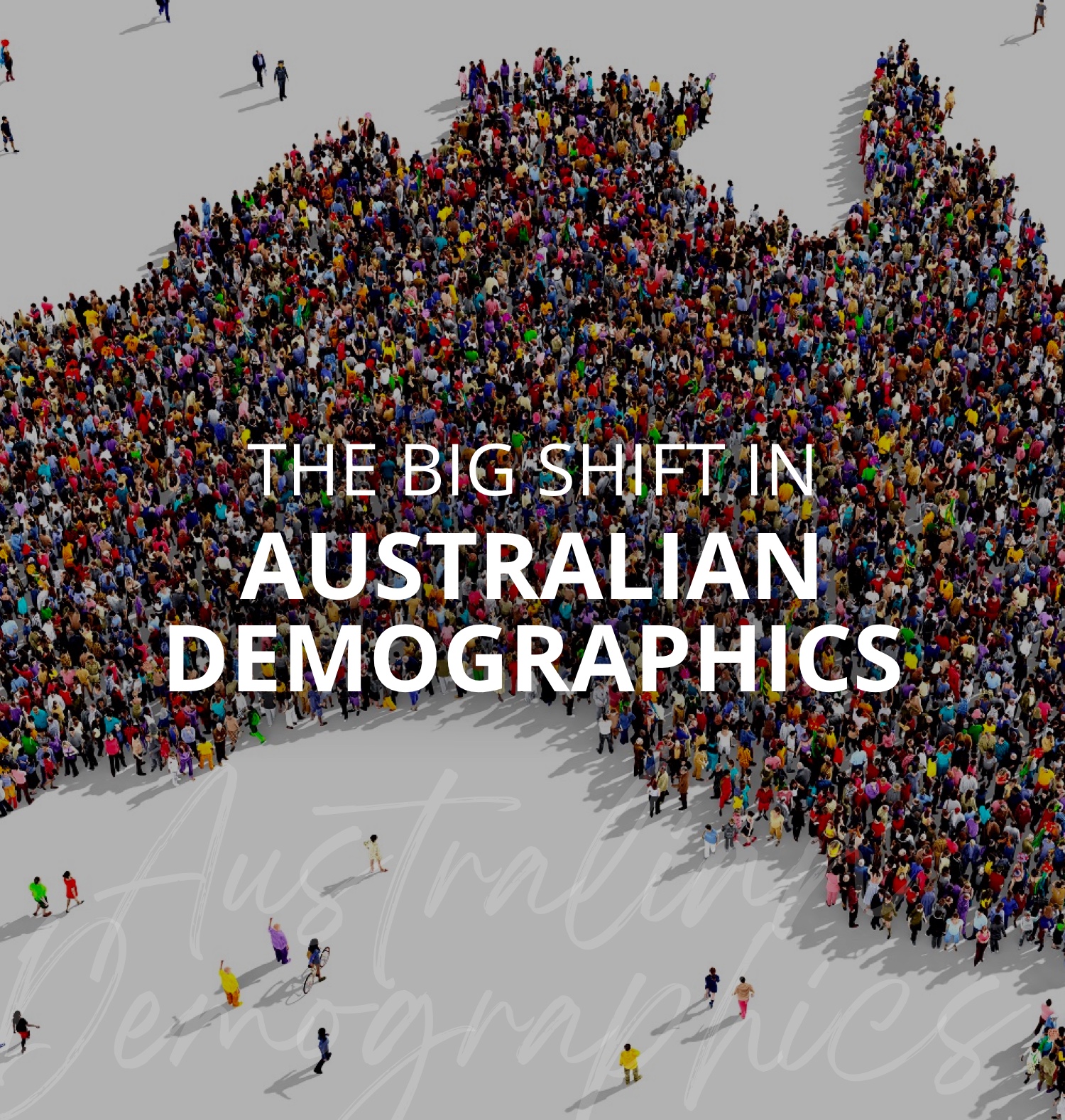Question: What does a sea change, tree change and smashed avo have in common?
Answer: A bloke by the name of Bernard Salt.
Question: Is it important to understand and interpret demographic data when purchasing property?
Answer: Yes.
Question: Are the 2 questions above in any way related?
Answer: Absolutely. And if you’re interested in property investment you might already know why. If not, let us tell you about Bernard Salt and his influence on how we determine demographic data.
On the go? Here’s 30 seconds of take outs:
- Bernard Salt has identified 3 prominent Australian cultures: bush, city and lifestyle.
- Today’s lifestyle culture sees Australians seeking beach-side living with access to lifestyle-enriching amenities.
- Before investing in property, it’s vital to consider what’s happening in the current market and what’s motivating to people buy and sell.
- As property investors, we also need to make predictions for the future.
- Looking to the past can help us identify trends that help us make future projections.
- Capital Properties keeps its fingers on the pulse of demographic and market changes.
Keep reading >>
Bernard Salt is a “speaker, a business advisor and a media commentator who is perhaps best known to the wider community for identifying and tagging new tribes and social behaviours such as the “Seachange Shift” and the “Man Drought”. He was also responsible for popularising smashed avocados… globally.”*
In other words, Bernard is a master of creating a story from data and identifying popular culture shifts that have occurred in Australia over the last 150 or so years. In fact, when we summarise Australian geographic and demographic culture, we can thank Bernard for identifying 3 prominent cultures.
The Australian demographic stories
Bernard tells us that in 19th century Australia there was a “bush culture”, where people yearned to live in rural ‘bush’ spaces. Then the data shows that a shift occurred in the 20th century where people sought out a “city / suburban culture”. And, later, in modern times, (i.e. the 21st century), us Aussies began to seek a “lifestyle culture”.
Lifestyle culture
Today, Australians favour an urban lifestyle over regional / bush living. The culture that’s emerged over the last 30 years or so is a natural evolution of the Australian golden era of “beach / lifestyle culture”. The Australian dream of living by the beach is at an all-time high. Just look at the booming population migration to Coffs Harbour, The Gold & Sunshine Coasts and the Melbourne Peninsulas. Suburbs are shifting from city-bound to beach-side. And it’s the pursuit of lifestyle that connects suburbia and the beach. We’ve spoken about this trend before in this blog: “The great interstate migrate”.
Demographics and property investment
An essential question to ask if you’re considering purchasing a property, either to live in or invest, is: What’s the motivating force behind the average Australian’s housing requirements?
In the not-too-distant past Australians migrated away from the city, believing that suburban living offered a better lifestyle than living in a busy, congested concrete jungle. Access to cars and better public transport made travel manageable, and the extra space afforded in suburbia allowed for more room to raise children and signalled a greater opportunity for success.
But we’re in the midst of yet another demographic shift right now. More than ever before, Australians are choosing to move to the coast to pursue the full sea change experience. And it’s vital to acknowledge what that means for the current market before investing in property.
What to consider before investing
When you’re looking for an investment opportunity, it’s vital to consider what’s happening in the market and what’s motivating to people buy and sell. We’ve written about investment trends before in our blog posts “Why interstate investment is so hot right now”. Because, at Capital Properties, we’re continually assessing what’s really motivating Australians. What’s enhancing or embellishing sales?
Right now, it’s lifestyle.
For the average Aussie, the biggest driver and motivator for buying property is the pursuit of a better lifestyle. The aspirational culture of living by the beach with access to the amenities required for modern living (i.e. healthcare, schools, retail and hospitality, etc) is absolutely trending.
Even our homes are reflecting this switch to lifestyle. Our ‘lifestyle’ havens in suburbia or on the beach now require seamless indoor/outdoor living, work-from-home spaces, and entertainment rooms. Houses are no longer just a roof over our heads.
Projecting future trends
So, we know what buyers are looking for right now, but as property investors, we also need to make predictions for the future.
Before we purchase a property, we must get used to taking a long-term view of why this will be a good investment over the next 30 years or more. We need to ask the question of how it might contribute to the ideal Australian lifestyle in 2030 or 2040, which is when you’ll want to sell the property.
Look to the past
In looking to the future, we must also consider the past. How has Australian culture changed over recent decades and how will these ongoing changes affect your decision-making process for buying property now and in the future?
Australia is a multicultural country. Made more so by a significant cultural shift in the 70’s & 80’s when many Greek and Italian families migrated from Europe. Their arrival and subsequent prosperity directly influenced modern building design in Australia. And their legacy continued to change how Australians live today. I’ll explain why.
How European migration in the 70s still affects the way we live
The newly immigrated European parents came from world of limited opportunities. They arrived in Australia with dreams of making the world a safer, more prosperous place for their kids. They had a fierce work ethic, sometimes working 2 – 3 jobs so they could send their kids to school, and build businesses for them to work in. A tireless effort to ensure their kids would have a greater opportunity in life. This toil resulted in a social contract with parents and their kids. The kids of that generation understood that in return, they must make their parents proud by exceeding at school and pursuing successful careers.
And so, we saw that homes started to change in the 70’s and 80’s. Indoor-outdoor living became popular, and houses were built or modified to demonstrate success to the outside world – or just the nosy neighbours! For example, a typical suburban home of 3 bedrooms and 1 bathroom would position the living room at the back of the house. The idea was that the homeowner would take their guests through the house with bedroom doors intentionally left open so that the guests might notice the many pillows and the sumptuous styling that showcased their new-found prosperity. Then the guests would gather around an island bench in the kitchen to dine on the latest dishes from the Women’s Weekly, or saunter outside to gardens that might have reminded them of ‘home’.
Lifestyle influences design
So, this consequence of greater prosperity and the cultural influence of the proud Mediterranean homeowners impacted Australian house design to influence the style of homes we live in even now. We can certainly thank them for the ever-popular indoor-outdoor design or ‘alfresco’ living we’ve come to love and our ever-evolving aspiration for ‘lifestyle’ living.
Today we’ll still find that style of house across Australia, from Point Piper in Sydney to the suburbs of Gympie in Queensland. And that’s because us Australians still recognise the importance of comfortable homes to provide a better lifestyle for ourselves and our families. And right now, the Australian dream is living by the beach. Hence the emergence of the super charged coastal property boom.
So, what’s next?
That’s the million-dollar question that we daresay even Bernard Salt can’t quite commit an answer to. Especially in the wake of a global pandemic. But like him, we keep our fingers on the pulse of each new demographic shift in Australia (and beyond). For example, we’re predicting an even larger shift towards eco-friendly builds and green energy. We’ve written about some of these trends before in “To solar or not to solar, that is the question”. And we make it our mission to keep you informed with each change and each opportunity.
We’d love to help you get started with a free Capital Properties discovery session. And our Pinnacle Support Program will keep you informed of everything you need to know to make informed property investment decisions.
While you’re here, check out our free investor tools: Online property investment toolkit | Book Your Pinnacle Program Review | Self Evaluation Tool
*www.bernard-salt.com.au






